NEW YORK, May 31 (Reuters) – The average price of gasoline in the United States rose 19 cents per gallon over the past two weeks as a weaker dollar boosted crude oil prices, according to a Lundberg Institutional Survey released on Sunday.
The survey of 5,000 gas stations in the United States showed the national average price of self-serve conventional unleaded gasoline touched $2.4929 per gallon on May 29, up 19.29 cents from May 15.
Trilby Lundberg said gasoline prices reflected higher crude oil prices. NYMEX crude oil futures closed Friday at $66.31 a barrel, compared with $56.34 on May 15.
The dollar touched a five-month low against a basket of currencies on Friday. A weaker dollar makes oil cheaper for holders of other currencies and tends to support prices.
She said it is normal for prices to rise at this time of year. A warm spring in the northern hemisphere and the arrival of summer means gasoline usually contains more ethanol and other additives to protect the environment, which can push up prices. She also said that the price of ethanol is also rising.
Lundberg noted that Chicago’s taxes are about 31 cents higher than Arizona’s. The city has the lowest gasoline prices, at $2.22 per gallon, and Chicago has the highest gasoline prices, at $2.76 per gallon.
According to Singapore, May 11, Asian oil paper prices edged up less than 1 percent on the 12-month forward curve Monday, with the market trading light in early trading. The fuel oil market remained well supported, with spot crack spreads remaining firm near minus $4.00 per barrel for the fourth consecutive session.
The jet kerosene market continued to be weak, weighed down by the H1N1 flu outbreak and increased supply from the Middle East. The spot May jet kerosene spread over diesel was flat, while the jet coal crack spread remained weak at below $8.00 per barrel.
The positive fuel oil spreads for the third quarter of this year compared to the fourth quarter, the fourth quarter compared to the first quarter of 2010 and the first quarter of 2010 compared to the second quarter were $4.08, $6.83 and $8.50 per ton, respectively, up 17 cents, 83 cents and $1.25 from the previous session and $1.00-2.00 higher than the level a week ago.
A derivatives trader said, “A steady buying interest began to surface in the market a week or two ago, mostly from ship owners who want to hedge their exposure to higher oil prices.”
Similarly, forward fuel oil crack spreads are also higher, with Q3, Q4 and Q1 next year crack spreads estimated at $4.32, $5.23 and $6.04 per barrel discount to Middle East Dubai crude, respectively, up 50 cents-$1.00 from late Friday’s trading.
Conversely, spot crack spreads were broadly flat, holding at firmer levels. The near-month May fuel oil crack spread was at minus $4.10 per barrel as of 0400 GMT, unchanged from the previous session.
Spot fuel oil inter-month spreads held steady at firm levels, with the May/June inverse spread and the June/July inverse spread at $2.88 and $1.13 per tonne, respectively, down slightly by 12.5 cents from the previous session. As of 0400 GMT, the June/July spread bid/offer was $1.00/$1.25.
May and June fuel oil paper estimates were up $1.00 and 77 cents, or 0.3 percent, at $343.25 and $340.38 per tonne, respectively, with no bids/offers.
The fuel oil market has now been firm for more than a month, supported by tight supply, as previous capacity cuts at European refineries led to lower arbitrage shipments from the West into the Asian market, with May and June arrivals set to be below their respective averages of 2.6-2.8 million tons and 2.2-2.4 million tons, respectively.
Aviation kerosene paper cargo market remains weak, weighed down by ongoing concerns over the H1N1 influenza A outbreak. The spot May jet fuel/diesel spread was reported flat in early trading after a confirmed case was reported in China.
May and June coal/diesel spreads were flat at weak levels, but spreads for other months were up 5-10 cents. As of 0400 GMT, the June coal/diesel spread was at 80 cents; no May bids/offers were seen.
Another derivatives trader said, “The market is concerned about the short-term impact of H1N1 flu, so May and June prices have slipped, but forward paper appears to be holding steady at this point.”
The near-month jet coal/diesel spread, a pricing tool, has fallen back from a near-record high level of $1.90 two weeks ago and is due to expire at the end of this week.
The June jet kerosene premium to Middle East Dubai crude was steady at just under $8.00 per barrel and was estimated at $7.77 per barrel, up a modest 22 cents, further evidence of market weakness.
May and June diesel paper estimates were at $64.75 and $64.53 per barrel, up 35 cents and 33 cents, or 0.5 percent, respectively, with no bids/offers seen.
The June naphtha discount to Brent crude fell below $5.00 per barrel and was estimated at $5.60 as of 0400 GMT, down $1.04 from the previous session.
Two Taiwanese refiners bought spot naphtha for June delivery at a deeper discount to previously purchased shipments, reflecting weak market popularity due to considerable supplies from Europe and the Middle East.






